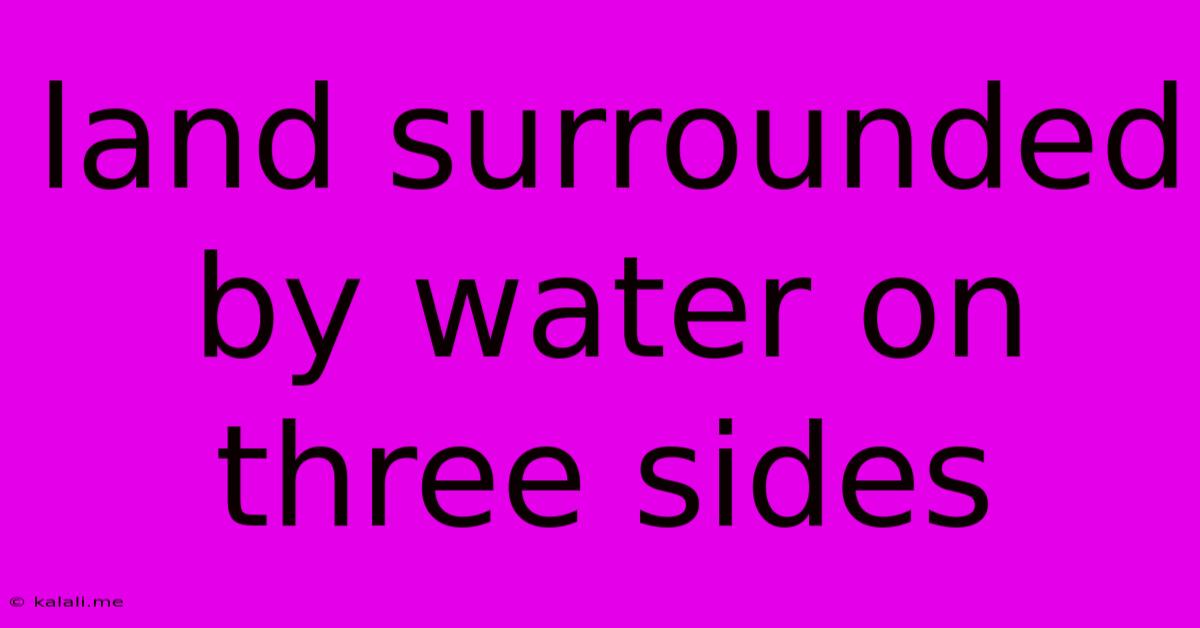Land Surrounded By Water On Three Sides
Kalali
Jun 13, 2025 · 3 min read

Table of Contents
Land Surrounded by Water on Three Sides: Exploring Peninsulas, Capes, and More
A landmass surrounded by water on three sides is a geographical feature with several names, depending on its size and characteristics. While the most common term is a peninsula, there are other possibilities, each with subtle but important distinctions. This article will explore these various landforms, delve into their formation, and highlight notable examples.
Understanding the nuances of these geographical terms is crucial for anyone interested in geography, environmental science, or simply appreciating the diverse landscapes of our planet. This comprehensive guide will help clarify the differences and provide a deeper understanding of these fascinating land formations.
What is a Peninsula?
The most common term for land surrounded by water on three sides is a peninsula. A peninsula is a relatively large piece of land projecting from a larger landmass into the surrounding water. It's essentially a piece of land that's "almost" an island, connected to the mainland by an isthmus – a narrow strip of land. Peninsulas can vary greatly in size, ranging from small, barely noticeable projections to vast landmasses encompassing entire countries. The size and shape are determined by geological processes, including tectonic activity and erosion. Think of the classic image of Italy "booting" down into the Mediterranean – that's a prime example of a peninsula.
Key Characteristics of a Peninsula:
- Surrounded by water on three sides: This is the defining characteristic.
- Connected to a larger landmass: The connection, called an isthmus, can vary in width.
- Relatively large size: While there's no strict size limit, peninsulas are generally substantial landmasses.
Other Similar Landforms: Capes and Headlands
While a peninsula is the most common term, two other landforms share similar characteristics: capes and headlands. These are smaller projections of land, often featuring dramatic cliff faces and rocky coastlines.
-
Cape: A cape is a relatively smaller point of land extending into a body of water, typically with a sharply pointed or curved shape. Capes are often rocky and less extensive than peninsulas. Think of Cape Cod in Massachusetts, or Cape Horn at the southern tip of South America – these are iconic examples of capes.
-
Headland: A headland is similar to a cape, a piece of land that juts out into the sea, often formed by resistant rock that has resisted erosion. The difference is sometimes subtle, with the distinction often based on local usage and the specific geological context. Headlands are frequently characterized by dramatic cliffs and coastal features.
Formation of Peninsulas, Capes, and Headlands:
The formation of these landforms is a complex process, often involving a combination of geological forces:
- Tectonic Activity: The movement of tectonic plates can create peninsulas by uplifting landmasses or through volcanic activity.
- Erosion: Over time, erosion can carve out peninsulas, capes, and headlands by selectively wearing away less resistant rock, leaving behind a projecting landform. Coastal erosion plays a significant role in shaping these features.
- Deposition: The deposition of sediment can also contribute to the formation of peninsulas, by building up land extending into a body of water.
Notable Examples Around the World:
- The Iberian Peninsula (Spain and Portugal): A large peninsula in Southwestern Europe.
- The Korean Peninsula: A peninsula in East Asia, separating the Yellow Sea from the Sea of Japan.
- The Florida Peninsula: A large peninsula in southeastern United States.
- Cape Canaveral: A prominent cape on the Atlantic coast of Florida.
Understanding the subtle differences between peninsulas, capes, and headlands allows for a more precise and nuanced understanding of coastal geography. These diverse landforms contribute significantly to the beauty and complexity of our planet's coastlines. Their formation is a testament to the powerful forces of nature shaping our world.
Latest Posts
Latest Posts
-
To Which Class Do Honey Bees Belong
Jun 14, 2025
-
Which Country Is Known As Land Of Midnight Sun
Jun 14, 2025
-
Which Of The Following Is True In A Normal Distribution
Jun 14, 2025
-
For This Truss Determine The Number Of Zero Force Members
Jun 14, 2025
-
Lewis Dot Structure For Maleic Acid
Jun 14, 2025
Related Post
Thank you for visiting our website which covers about Land Surrounded By Water On Three Sides . We hope the information provided has been useful to you. Feel free to contact us if you have any questions or need further assistance. See you next time and don't miss to bookmark.